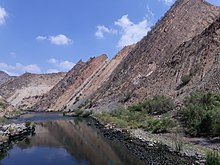



Traditionally in geomorphology, a flatiron is a steeply sloping triangular landform created by the differential erosion of a steeply dipping, erosion-resistant layer of rock overlying softer strata. Flatirons have wide bases that form the base of a steep, triangular facet that narrows upward into a point at its summit. The dissection of a hogback by regularly spaced streams often results in the formation of a series of flatirons along the strike of the rock layer that formed the hogback. As noted in some, but not all definitions, a number of flatirons are perched upon the slope of a larger mountain with the rock layer forming the flatiron inclined in the same direction as, but often at a steeper angle than the associated mountain slope. The name flatiron refers to their resemblance to an upended, household flatiron.
Background
The Flatirons near Boulder, Colorado, is both an example of these landforms and the source of their name. Other well-developed flatirons are found in the eastern Uinta Mountains in northwestern Colorado, the Waterpocket Fold in Capitol Reef National Park, the Superstition Mountains near Phoenix, Arizona, and on the flanks of the Marathon Uplift in west Texas.
The term "flatiron" is also used for very small-scale landforms that are known as pediment flatirons and talus flatirons. These landforms are small knolls with a triangular to trapezoidal-shaped sloping surface with the long side of this surface as their base and a point at their top. Both pediment flatirons and talus flatirons are associated with the scarps of a cuesta, mesa, or butte and with their tips directed towards the scarp. Both types of these flatirons are typically separated from the scarp by well-defined ravines and gullies. These flatirons consist of either talus, in the case of the talus flatirons, or pedisediment and colluvium that cover pediments, in the case of pediment flatirons. Their surfaces are protected by a thin layer of caprock. The caprock commonly consists of caliche, which is about 2 meters (6.6 ft) thick and rarely as much as 5 meters (16 ft) thick, that has developed in either talus, pedisediment, or colluvium. Talus flatirons lie within the scarp slope – and pediment flatirons occur within the transition zone between scarp and foreland. Pediment flatirons can merge downward into a fluvial terrace. Both talus and pediment flatirons are the relict remnants of formerly active slope systems that were once part of the scarp's history.
See also
- Cuesta – Hill or ridge with a gentle slope on one side and a steep slope on the other
References
- ^ MaCleod, B. (2009) Southern Margin of the Marathon Basin. Big Bend Photographs, Texas Geological Press.
- Ollier, C.D. (1985) Glossary of Morphotectonics, 2nd ed. Bureau of Mineral Resources. Geology and Geophysics Record no. 1985/30. Dept. of Geology and Geophysics, Canberra, Australia. 55 pp. ISBN 978-0858347465
- Fairbridge, R.W. (1968) Hogback and Flatiron. In R.W. Fairbridge, ed., pp. 524-525, The Encyclopedia of Geomorphology (Encyclopedia of Earth Sciences, Volume III), Reinhold, New York, 1296 pp. ISBN 978-0879331795
- Huggett, JL (2011) Fundamentals of Geomorphology. Routledge. New York, New York. 516 pp. ISBN 978-0-415-56774-9
- Jackson, JA, J Mehl and K Neuendorf (2005) Glossary of Geology. American Geological Institute, Alexandria, Virginia. 800 pp. ISBN 0-922152-76-4
- Hansen, WR (2005) The Geologic Story of the Uinta Mountains. Bulletin no. 1291 Archived 2015-01-27 at the Wayback Machine, United States Geological Survey, Reston, Virginia.
- Schmidt, K-H (1989) Talus and pediment flatirons – erosional and depositional features on dryland cuesta scarps. Catena Supplement 14:107-118.
- Schmidt, K-H (2009) Hillslopes as Evidence of Climatic Change. In AJ Parsons and AD Abrahams, eds., pp. 675-694, Geomorphology of Desert Environments, 2nd ed., Springer Science+Business Media, New York, New York, 831 pp. ISBN 978-1-4020-5718-2
External links
- Ball, J. (2009) Flatirons ≠ pyramids, but they're still cool, Magma Cum Laude, American Geophysical Union Blogosphere, November 25, 2009. last accessed January 24, 2014.
This article about structural geology is a stub. You can help Misplaced Pages by expanding it. |
This article related to topography is a stub. You can help Misplaced Pages by expanding it. |
This erosion article is a stub. You can help Misplaced Pages by expanding it. |